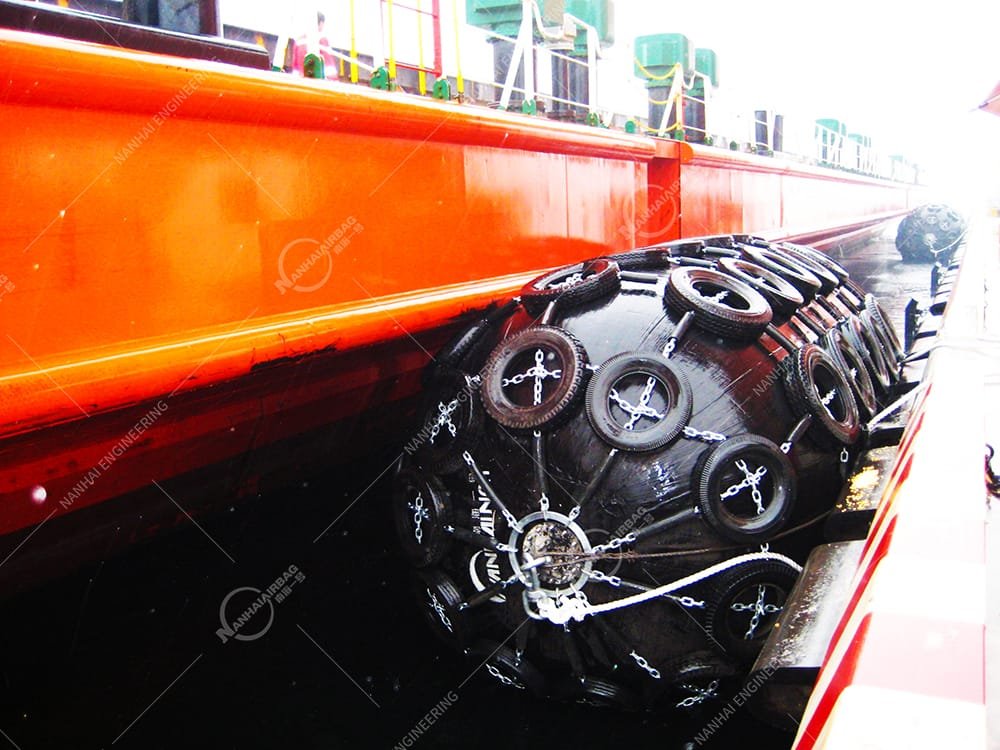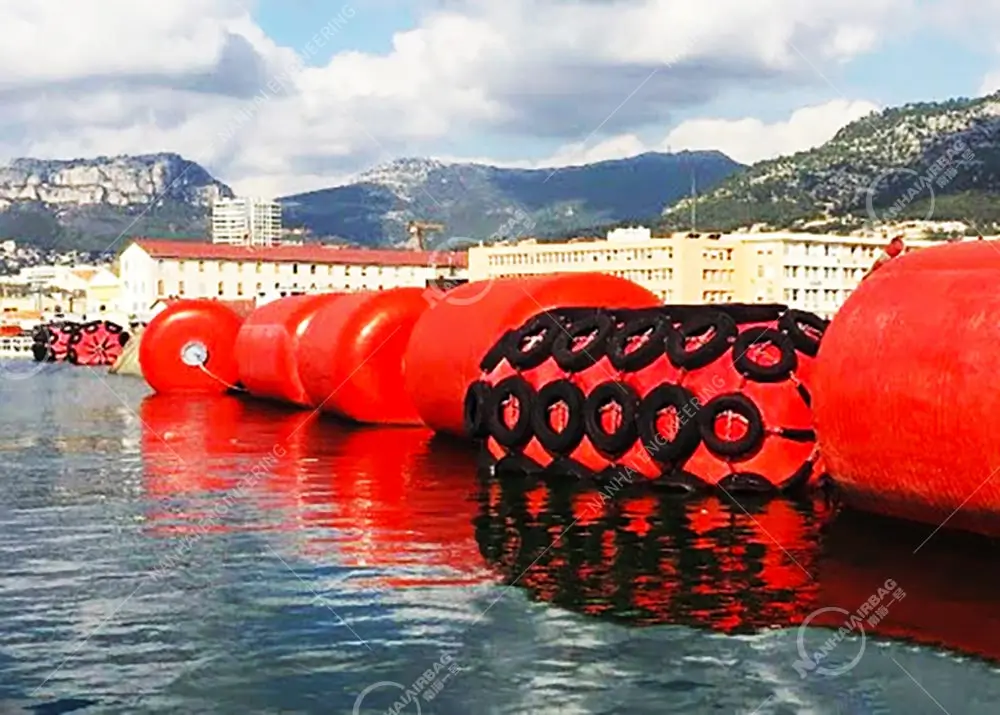What is a LNG vessel?
08/28/2025Why is hot vulcanization essential for marine rubber fenders?
08/29/2025What types of fenders can be used in ship to ship operation?
When two massive vessels come alongside each other at sea, there’s little room for error. Ship-to-ship (STS) operations — whether transferring crude oil, LNG, chemicals, or dry bulk — rely heavily on fenders to keep both hulls safe. Choosing the right fender type can make the difference between a smooth transfer and costly hull damage.
In this guide, we’ll break down the main STS fender options — from pneumatic rubber fenders to foam-filled fenders and smaller secondary fenders — and help you decide which setup is right for your operation.
Why Fenders Are Crucial in STS Operations
STS transfers involve two vessels moored side by side, sometimes for several hours, while cargo flows between them. Even in calm conditions, factors like swell, wind, and tide can push the hulls together. Without proper fendering:
- Hull plating can deform
- Protective coatings can scrape away
- Manifolds may misalign, delaying transfers
- Worst case, you face costly structural repairs
Fenders absorb energy from vessel movement and create a safe stand-off distance. For large tankers, a single STS setup can involve multiple high-performance fenders positioned along the parallel body to distribute loads evenly.
Primary Fender Types Used in STS Operations
1. Pneumatic Rubber Fenders (Yokohama Type)
Pneumatic fenders — often called Yokohama fenders — are the most widely used for STS transfers. They’re large, cylindrical air-filled fenders designed to absorb enormous impact energy while keeping reaction forces on the hull low.
Variants:
- CTN (Chain-Tyre-Net): A durable net of chains and used tires protects the fender body. Perfect for rough offshore conditions.
- Sling Type: A lighter alternative without CTN, easier to handle but better suited for moderate conditions.
Key benefits:
- Excellent energy absorption-to-weight ratio — ideal for large tankers
- Performs well across wide temperature ranges (even sub-zero for LNG)
- Simple deployment and retrieval, especially offshore
- Available in 50 kPa and 80 kPa pressure ratings, offering flexibility
Considerations:
- Requires periodic pressure checks
- Needs protective nets in high-debris areas
- Bulkier to transport and store
Best suited for: Crude oil STS, LNG/LPG transfers, Aframax to VLCC operations, and offshore terminals.

2. Foam-Filled Fenders
Foam-filled fenders are built around a closed-cell foam core wrapped in a tough polyurethane or nylon skin. Unlike pneumatic fenders, they don’t rely on air pressure, making them puncture-proof and virtually maintenance-free.
Advantages:
- No inflation required — reduced operational prep time
- Highly resistant to punctures and tearing
- Performs well in high-frequency STS environments
- Handles floating debris better than pneumatic fenders
Trade-offs:
- Heavier and more challenging to deploy
- Energy absorption slightly lower than equivalent-size pneumatic fenders
- If the outer skin gets damaged, repairs can be costly
Best suited for: High-turnover STS locations, ports with floating debris, and operators seeking low-maintenance solutions.

3. Comparing Pneumatic vs. Foam-Filled Fenders
| Feature | Pneumatic Fenders | Foam-Filled Fenders |
|---|---|---|
| Energy Absorption | Higher for same size | Slightly lower |
| Reaction Force | Lower (gentler on hulls) | Slightly higher |
| Maintenance | Requires pressure checks | Virtually zero maintenance |
| Durability | Protected with CTN | Puncture-proof core |
| Weight | Lightweight | Heavier |
| Cost | Lower upfront | Higher upfront |
| Best Use | Offshore, LNG, VLCC STS | High-frequency STS, debris-prone zones |
Secondary Fenders in STS Operations
While primary fenders handle the heavy lifting, secondary fenders protect more vulnerable areas:
- Bow and stern zones where hull flare creates smaller contact points
- Manifold regions where extra clearance is critical
- Smaller boat-to-ship transfers
Secondary fenders are usually smaller polyurethane or inflatable types, easy to deploy and reposition as needed.
Special Cases: LNG, LPG, and Chemical STS Transfers
For LNG/LPG STS operations, safety requirements are stricter:
- Fenders must have anti-static properties
- Low-temperature performance is essential (down to -50°C)
- Non-sparking accessories are recommended
For chemical transfers, ensure fender materials resist solvent exposure in case of spills.
How to Choose the Right Fender for STS Operations
Selecting fenders isn’t just about size. Consider these factors:
- Energy absorption needs — based on vessel displacement, approach speed, and sea state.
- Reaction force limits — to avoid overstressing hull plating.
- Operating environment — open sea vs. sheltered anchorage, swell, and debris risk.
- Temperature range — especially for LNG or Arctic STS.
- Handling and logistics — weight, crane capacity, storage, and transportation.
- Certifications — compliance with OCIMF and ISO 17357-1 standards.
Fender Layout and Deployment Best Practices
A typical STS setup involves:
- 4–6 primary pneumatic or foam-filled fenders positioned along the parallel body
- Secondary fenders near bow and stern flare areas
- Proper spacing to ensure even load distribution
- Sufficient vertical coverage for tidal range and trim/list differences
Pro tip: Always inspect shackles, slings, and guy ropes before deployment. For pneumatic fenders, log pressure readings before and after each operation.
Common Mistakes to Avoid
- Undersizing fenders: Choosing based only on vessel size without factoring in approach speed or displacement.
- Using too few fenders: Leads to uneven loading and potential hull damage.
- Ignoring anti-static needs: Critical for LNG/LPG STS safety.
- Poor storage practices: Overexposure to UV and saltwater reduces lifespan.
FAQ
Q1: What type of fenders are most common in STS operations?
Pneumatic rubber fenders, especially CTN type, are the most common due to their high energy absorption and adaptability.
Q2: Are foam-filled fenders suitable for offshore STS?
Yes, but pneumatic fenders are usually preferred offshore due to their lighter weight and higher EA.
Q3: Do LNG STS operations require special fenders?
Absolutely — fenders must be anti-static, low-temperature rated, and fitted with non-sparking accessories.
Q4: How many fenders are typically used in an STS transfer?
For MR-to-Aframax STS, usually 4–6 primary fenders plus smaller secondary fenders at flare points.
Final Thoughts
In STS operations, pneumatic rubber fenders and foam-filled fenders dominate the scene, each with strengths tailored to specific conditions. Pneumatic fenders offer unmatched energy absorption and flexibility, while foam-filled options excel in low-maintenance, high-turnover environments.
If you’re unsure which setup is right for your vessels, it’s always best to consult with a specialist. At NANHAI, we help operators choose the right STS fender systems — ensuring safety, compliance, and cost-efficiency.
